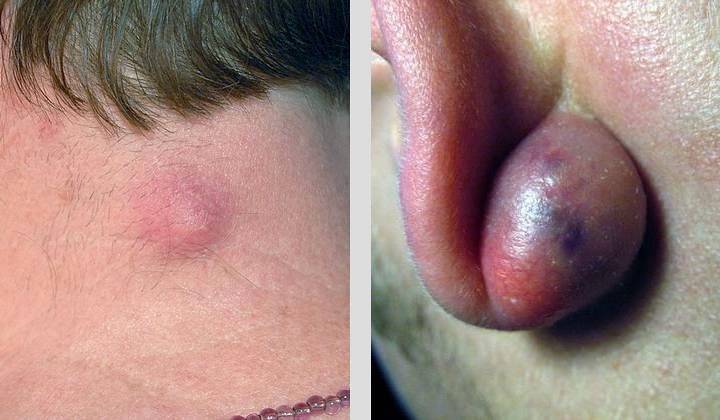 Cysts may be small, although as in the example on a patient’s ear lobe, they are able to grow and/or become infected.
Cysts may be small, although as in the example on a patient’s ear lobe, they are able to grow and/or become infected.
A skin cyst is a fluid filled lump beneath your skin. They can be referred to as sebaceous cysts, although this should only describe a less common type of cyst, which is filled with the oily liquid secreted by sebaceous glands.
Most cysts fall into two types, epidermoid and pilar. Both form a closed sac containing what can look like toothpaste, or soft cheese, perhaps more liquid. This is derived from keratin, the material which makes our hair, nails and the skin’s outer layer.
Keratin bearing cells normally move through the skin to be shed but can instead go deeper and multiply, forming a sac, into which they secrete keratin.
Epidermoid cysts arise from epidermal (outer layer of the skin) cells and are the most common type, appearing on the face, neck, genitals, or trunk. Pilar cysts come from cells found in the roots of hairs and appear in related areas, including the scalp.
Symptoms & Diagnosis
Skin cysts can vary from pea sized to much larger, dome shaped bumps, generally white, or yellow. They are not normally painful but may redden and become sore if they are infected. A foul smell from any pus coming out also suggests infection.
In most cases, a consultant at our London clinic will be able to diagnose a cyst visually. There can be a need for a biopsy, or a scan for very large cysts but either are quite rare. Accurate diagnosis is however important, as cysts look similar to boils, or abscesses.
A cyst can ultimately cause an abscess in a few cases, or become infected in its own right. This aspect is considered, along with your medical history, or related issues within your family. Cysts can be hereditary, or a symptom of Gardner, or Gorlin Syndrome.
Treatment For Cysts
Please do not try to burst, or drain a cyst yourself, this could cause any infection to spread and the cyst may well grow back anyway.
Whilst most cysts are not a health risk, they can be unsightly, interfere with life, catch on clothing, or become infected. Should you choose removal, this can be carried out by a consultant dermatologist under relatively mild, local anaesthetic.
The key is to remove the entire wall of the cyst, to significantly reduce the chance of this growing back. In most cases, removal can take place during one visit, although notable infection may sometimes requires two stages.
Incision and drainage, along with a course of antibiotics should clear the infection, which can make the cyst wall fragile. Once this has stabilised, ensuring the whole wall is removed becomes more practical.
After removal, any discomfort you felt from the cyst should be gone, along with the dislike of this being there. The most skilful excision can leave a scar, although this will be relatively nominal.
Seeking Support
Whenever you find a lump of any form on your skin, you should consult a dermatologist. This may not be a cyst, even if you are fairly sure, accurate diagnosis and prompt treatment when required bring certainty.
For skin cysts, this will also bring a return to normality through quite minimal treatment. Specialist support is available at our London clinic, along with any advice you need on the treatment of a range of cysts.
You may find the options below useful:
- Alphabetic Dermatology Menu: Conditions & Treatments.
- Up to date news and insight in: Our Dermatology Blog.
For any advice, or to arrange a dermatology appointment, call 020 3535 7850, or send an email via the Make An Appointment button below.
